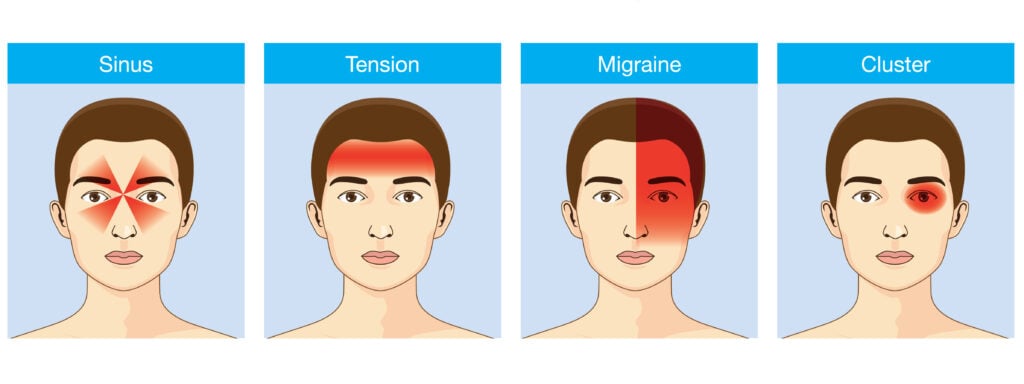What are migraine headaches?
Migraines are a complex headache disorder that involves recurrent episodes of strong headaches. According to Statistics Canada, approximately 2.7 million Canadians (or 8.3% of the population) suffer from migraines. Often, migraines can prevent individuals who suffer from them from carrying on with their daily activities, such as driving, and from getting a good night’s sleep.
What are the symptoms of migraine headaches?
The main symptom of a migraine headache is typically an intense headache on one side of the head (although some individuals can experience pain on both sides of the head). The pain is usually moderate to severe in intensity and feels like a throbbing sensation. Usually, the pain felt during a migraine headache gets worse when you move.
Here are some other symptoms felt during a migraine headache:
- Nausea and vomiting, as well as dizziness and food intolerance
- Extreme sensitivity to light and sound
- Irritability
In addition, many individuals suffering from migraines also report experiencing “migraine aura,” which has the following characteristics:
- The aura often occurs prior to the headache, but sometimes occurs during or after migraines
- Often, the visual aura consists of seeing “floaters” or bright spots and often happens in combination with vision blurring
- The aura typically occurs visually, but sometimes, it can be sensory or motor, or consist of a combination of these symptoms.
What are the causes of migraine headaches?
Currently, scientists think that migraines occur due to both environmental and genetic factors. So far, research studies have identified a number of genetic factors that can contribute to the development of migraines. In fact, genetics plays an important role in the development of migraines. Statistics show that 70% of migraine sufferers have a first-degree relative with a history of migraines. So far, research studies have demonstrated that migraines with aura have a stronger genetic component than migraines without aura.
Several specific factors can also trigger migraines in susceptible individuals. These include stress, hunger, and fatigue. Specifically, psychological stress often acts as a trigger for migraines. It seems that hormonal changes can also influence the onset of migraines, which often occur around the time of menstruation, menopause, or pregnancy, or due to the use of oral contraceptives. Other factors associated with triggering migraines include smoking, alcohol consumption, sleep problems, fasting or skipping meals, and use of certain medications.
Diet can also serve as a trigger for migraine headaches. Dietary intolerance to some compounds called biogenic amines can also trigger migraines. Specifically, the trace amine tyramine, derived from the amino acid tyrosine, has been associated with triggering migraine headaches. Tyramine is contained in higher quantities in smoked and fermented foods, as well as in foods containing soy and in most cheeses.
What are the Different Types of migraines?

The main symptom of a migraine headache is typically an intense headache on one side of the head (although some individuals can experience pain on both sides of the head). The pain is usually moderate to severe in intensity and feels like a throbbing sensation.
Headache Migraine There are two main types of migraines: migraine without aura and migraine with aura.
Migraine without aura is the most common type of migraine headache. The symptoms of a migraine without aura include pulsating headache which is moderate to severe in terms of pain. This type of migraine often has a sudden onset, and commonly comes with nausea, dizziness, sensitivity to light, sound, or smells. Migraine without aura typically lasts from several hours to several days.
Migraine with aura is less typical and comes with visual disturbances and other symptoms, such as abnormal sensations or weakness on one side of the body, and tingling of the hands and face. These symptoms typically occur up to one hour before the headache.
Other types of migraine include:
Chronic migraine – this type of migraine involves headaches occurring on 15 or more days per month for more than 3 months.
Hemiplegic migraine – this is a rare but serious form of migraine which causes temporary paralysis to one side of the body.
Migraine without Headache – this type of migraine involves visual problems or other “aura” symptoms, including nausea, vomiting, and dizziness, but without actual headache.
Migraine with Brainstem Aura – this type of migraine often occurs in adolescents, and specifically, in teenage girls. The symptoms involve temporary vision loss, dizziness, loss of muscle coordination, slurred speech, and fainting.
What are the treatment options for migraines?
Medication
Some medications can stop the progression of a migraine, and are called “abortive” migraine medications. These include some selective serotonin receptor agonists (such as triptans), ergotamines, and analgesics.
A number of medications can be prescribed to prevent the occurrence of migraines, and these are referred to as “preventive” migraine medications, which include antiepileptic drugs, beta-blockers, non-steroidal anti-inflammatory drugs (NSAIDs), and botulism toxin (Botox). Some medical practitioners may recommend magnesium supplementation to treat the severity and frequency of migraine headaches.
Alternative treatments
Migraine headaches are often managed by medication, but some individuals do not tolerate migraine medication due to side effects or prefer to avoid medication for other reasons. A number of alternative therapies exist to reduce or prevent the occurrence of migraines.
Acupuncture and manual therapies. Several types of acupuncture have been proven to be an effective method in migraine prevention. In addition, manual therapies, such as chiropractic manipulation, physiotherapy, and massage treatment have been shown to be as effective as certain medications used to treat migraines. Stress reduction techniques, such as relaxation techniques and yoga, can also be used to prevent migraines.
Lifestyle changes. Effective migraine prevention strategies that do not involve taking prescription medication include lifestyle changes and focus on the reduction of migraine triggers (improving quality of sleep, exercising, reducing stress levels, as well as avoiding cigarette smoke, alcohol, and certain foods).
Other non-pharmacologic treatments. Other therapies used to reduce the severity and frequency of migraines include biofeedback and cognitive-behavioural therapy (CBT). Transcranial magnetic stimulation (TMS) and vagus nerve stimulation (nVS) have also been shown to be effective in reducing the frequency and severity of migraine headaches.
Surgery. In some severe cases, surgery involving the decompression of some nerves around the head and neck can be used to treat migraines that do not respond to medications and non-pharmacological treatments.

